Spark2.X—Deploy模块解析
模块整体架构
Deploy模块是Spark standalone的分布式框架,其采用了master/slave架构,主要包括以下几个进程。
Master:
1)接受worker注册并管理所有的worker,并命令Worker启动Driver和Executor
2)接受client提交的Application,并将Application提交给worker.
Worker:
1)启动时,向Master注册自己,定期向Master汇报心跳
2)接受Master的命令,启动Driver和Executor。
Client:
向Master提交Application,并注册在master监控Application的状态。
Driver:
一个Spark作业运行时包括一个Driver进程,也是作业的主进程,负责DAG图的构建,stage划分,task的管理和调度,主要包括DAGScheduler,TaskScheduler及SchedulerBackend.
Executor:
1)Executor接收Driver的命令
2)一个Executor可以执行一个或多个task
Standalone有两种部署模式:client和cluster
Client模式:即Driver运行在Client.
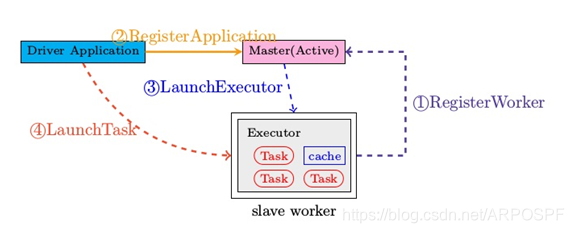 图1 Client模式下的交互图
图1 Client模式下的交互图
更详细的架构图如下:
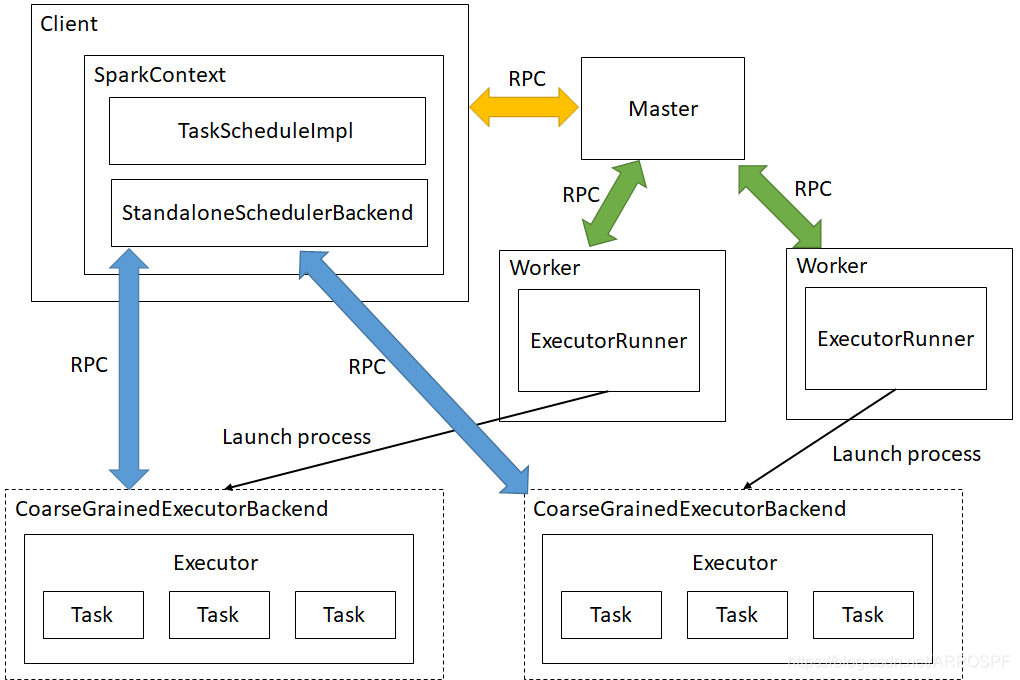
Client模式
Cluster模式:Driver运行在Executor.
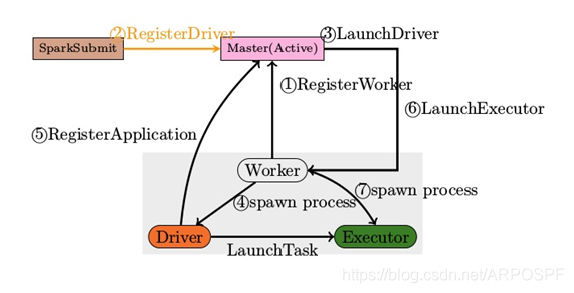
图2:Cluster模式下的交互图
更详细的架构如下:
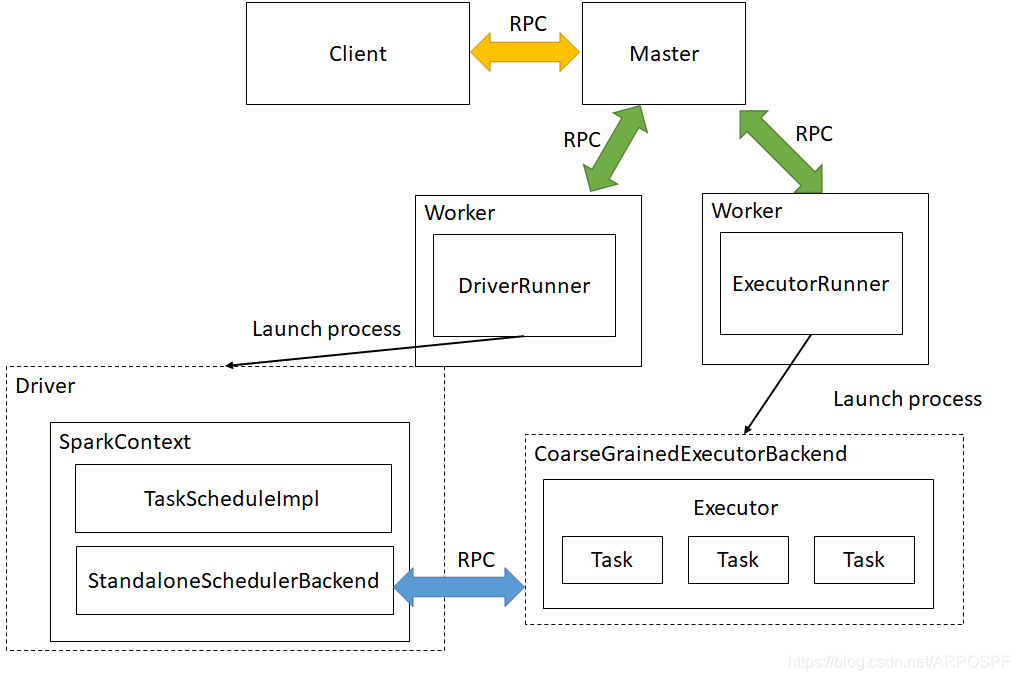
消息传递机制详解
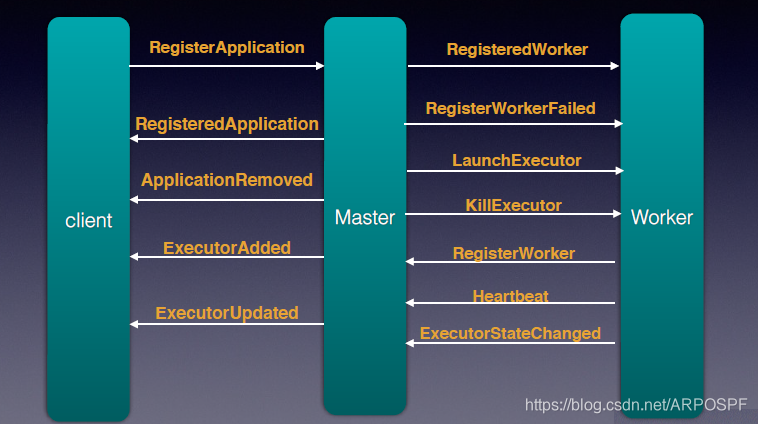
图3 消息传递机制示意图
Master和Worker
Worker->Master:
case class RegisterWorker(
id: String,
host: String,
port: Int,
worker: RpcEndpointRef,
cores: Int,
memory: Int,
workerWebUiUrl: String)
extends DeployMessage {
Utils.checkHost(host, "Required hostname")
assert (port >0)
}
case class ExecutorStateChanged(
appId: String,
execId: Int,
state: ExecutorState,
message: Option[String],
exitStatus: Option[Int])
extends DeployMessage
case class DriverStateChanged(
driverId: String,
state: DriverState,
exception: Option[Exception])
extends DeployMessage
case class WorkerSchedulerStateResponse(id: String, executors: List[ExecutorDescription],
driverIds: Seq[String])
case class WorkerLatestState(
id: String,
executors: Seq[ExecutorDescription],
driverIds: Seq[String]) extends DeployMessage
case class Heartbeat(workerId: String, worker: RpcEndpointRef) extends DeployMessage
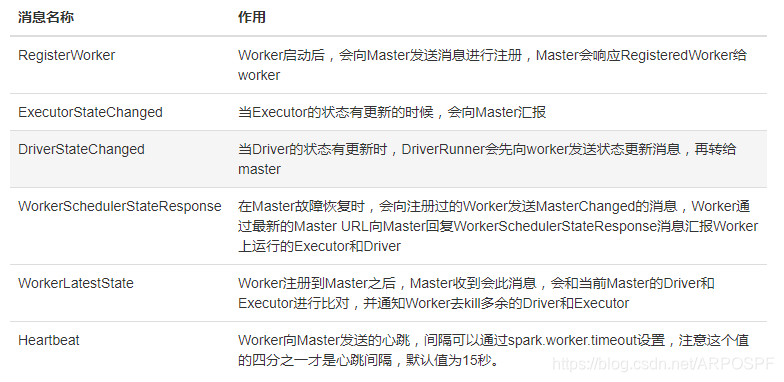
Master->Worker:
case class RegisteredWorker(master: RpcEndpointRef, masterWebUiUrl: String) extends DeployMessage with RegisterWorkerResponse
case class RegisterWorkerFailed(message: String) extends DeployMessage with RegisterWorkerResponse
case class ReconnectWorker(masterUrl: String) extends DeployMessage
case class KillExecutor(masterUrl: String, appId: String, execId: Int) extends DeployMessage
case class LaunchExecutor(
masterUrl: String,
appId: String,
execId: Int,
appDesc: ApplicationDescription,
cores: Int,
memory: Int
)extends DeployMessage
case class LaunchDriver(driverId: String, driverDesc: DriverDescription) extends DeployMessage
case class KillDriver(driverId: String) extends DeployMessage
case class ApplicationFinished(id: String)
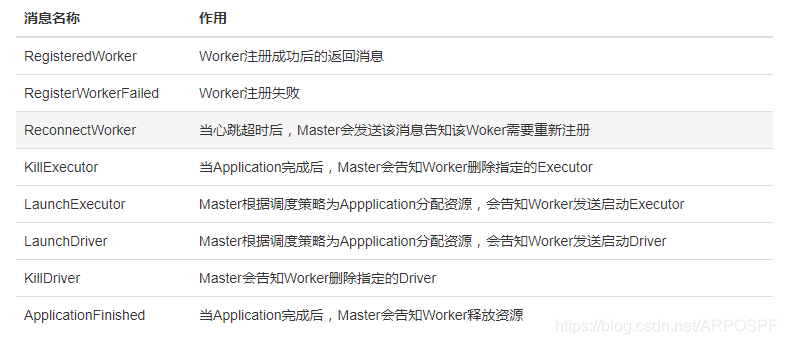
Master和Client
** DriverClient -> Master**:
// DriverClient <-> Master
case class RequestSubmitDriver(driverDescription: DriverDescription) extends DeployMessage
case class SubmitDriverResponse(
master: RpcEndpointRef,
success: Boolean,
driverId: Option[String],
message: String) extends DeployMessage
case class RequestKillDriver(driverId: String) extends DeployMessage
case class KillDriverResponse(
master: RpcEndpointRef,
driverId: String,
success: Boolean,
message: String) extends DeployMessage
case class RequestDriverStatus(driverId: String) extends DeployMessage
case class DriverStatusResponse(
found: Boolean,
state: Option[DriverState],
workerId: Option[String],
workerHostPort: Option[String],
exception: Option[Exception]
)
Driver和Executor
// Driver to executors
case class LaunchTask(data: SerializableBuffer) extends CoarseGrainedClusterMessage
case class KillTask(taskId: Long, executor: String, interruptThread: Boolean)
extends CoarseGrainedClusterMessage
case object RegisteredExecutor extends CoarseGrainedClusterMessage with RegisterExecutorResponse
case class RegisterExecutorFailed(message: String) extends CoarseGrainedClusterMessage
with RegisterExecutorResponse

// Executors to driver
case class RegisterExecutor(
executorId: String,
executorRef: RpcEndpointRef,
hostname: String,
cores: Int,
logUrls: Map[String, String]) extends CoarseGrainedClusterMessage
case class StatusUpdate(
executorId: String,
taskId: Long,
state: TaskState,
data: SerializableBuffer) extends CoarseGrainedClusterMessage

Standalone模式下的Executor模块分析
Executor模块是负责运行Task计算任务,并将结果返回给Driver,尽管Spark支持多种资源调度框架,比如mesos,yarn,standalone,这些资源框架在分配资源后,最后都会让Executor完成最后的计算
下面主要介绍Standalone模式下Executor模块交互过程
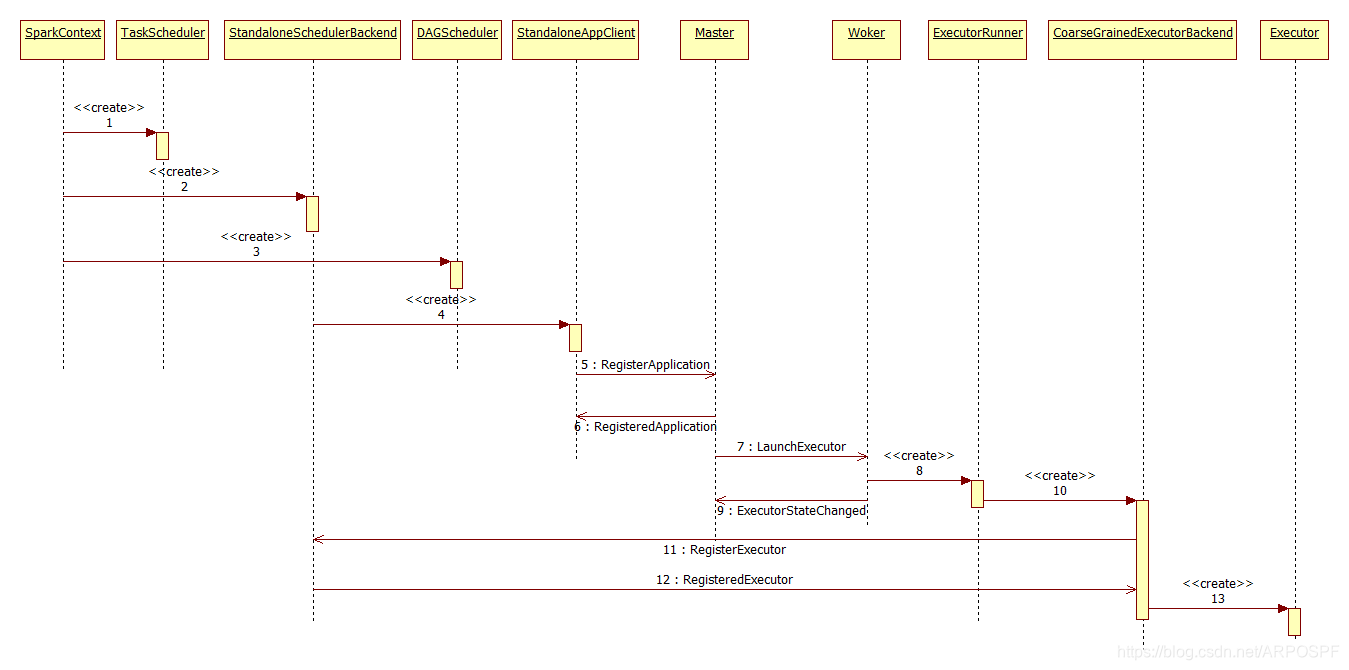
Step 1-4 :SchedulerBackend创建StandaloneAppClient
// Create and start the scheduler
val (sched, ts) = SparkContext.createTaskScheduler(this, master, deployMode)
_schedulerBackend = sched
_taskScheduler = ts
_dagScheduler = new DAGScheduler(this)
……
// start TaskScheduler after taskScheduler sets DAGScheduler reference in DAGScheduler's
// constructor
_taskScheduler.start()
** Step 5-6 :StandaloneAppClient向Master注册Application
首先StandaloneAppClient调用Start,初始化RPCEnv
endpoint.set(rpcEnv.setupEndpoint("AppClient", new ClientEndpoint(rpcEnv)))
初始化过程调用了registerWithMaster,最终调用tryRegisterAllMasters
private def registerWithMaster(nthRetry: Int) {
registerMasterFutures.set(tryRegisterAllMasters())
registrationRetryTimer.set(registrationRetryThread.schedule(new Runnable {
override def run(): Unit = {
if (registered.get) {
registerMasterFutures.get.foreach(_.cancel(true))
registerMasterThreadPool.shutdownNow()
} else if (nthRetry >= REGISTRATION_RETRIES) {
markDead("All masters are unresponsive! Giving up.")
} else {
registerMasterFutures.get.foreach(_.cancel(true))
registerWithMaster(nthRetry + 1)
}
}
}, REGISTRATION_TIMEOUT_SECONDS, TimeUnit.SECONDS))
}
向所有的Master注册Application
private def tryRegisterAllMasters(): Array[JFuture[_]] = {
for (masterAddress <- masterRpcAddresses) yield {
registerMasterThreadPool.submit(new Runnable {
override def run(): Unit = try {
if (registered.get) {
return
}
logInfo("Connecting to master " + masterAddress.toSparkURL + "...")
val masterRef = rpcEnv.setupEndpointRef(masterAddress, Master.ENDPOINT_NAME)
masterRef.send(RegisterApplication(appDescription, self))
} catch {
case ie: InterruptedException =>// Cancelled
case NonFatal(e) => logWarning(s"Failed to connect to master $masterAddress", e)
}
})
}
}
Master收到RegisterApplication后,创建ApplicationInfo,并将其放到自己的数据结构中
caseRegisterApplication(description, driver) =>
if (state == RecoveryState.STANDBY) {
// ignore, don't send response
}else {
logInfo("Registering app " + description.name)
val app = createApplication(description, driver)
registerApplication(app)
logInfo("Registered app " + description.name + " with ID " + app.id)
persistenceEngine.addApplication(app)
driver.send(RegisteredApplication(app.id, self))
schedule()
}
private def registerApplication(app: ApplicationInfo): Unit = {
val appAddress = app.driver.address
if (addressToApp.contains(appAddress)) {
logInfo("Attempted to re-register application at same address: " + appAddress)
return
}
applicationMetricsSystem.registerSource(app.appSource)
//保存在Master上所有Application
apps += app
//app.id是在Master端分配的,格式是”app-currentdate-nextAppNumber,其中nextAppNumber是Master启动以来注册Application的总数-1,取四位数”
idToApp(app.id) = app
endpointToApp(app.driver) = app
addressToApp(appAddress) = app
//等待被调度的Application
waitingApps += app
if (reverseProxy) {
webUi.addProxyTargets(app.id, app.desc.appUiUrl)
}
}
Step 7:Master根据StandaloneApplication提交的应用信息选择Worker
org.apache.spark.deploy.master.Master#schedule为处于等待分配资源的Application分配资源,在每次有新的Application加入或者新的资源加入时都会调用schedule进行调度。为Application分配资源选择Worker,有两种策略:
1) 尽量打散,即将Application尽可能多地分配到不同节点,可以通过设置spark.deploy.spreadOut来实现,默认值为true。
2) 尽量集中,即将Application尽可能分配到很少的节点上。CPU密集型同时内存又占用的少的Application适合这种策略。
/**
Schedule and launch executors on workers
*/
private def startExecutorsOnWorkers(): Unit = {
// Right now this is a very simple FIFO scheduler. We keep trying to fit in the first app
// in the queue, then the second app, etc.
for (app <- waitingApps if app.coresLeft >0) {
val coresPerExecutor: Option[Int] = app.desc.coresPerExecutor
// Filter out workers that don't have enough resources to launch an executor
val usableWorkers = workers.toArray.filter(_.state == WorkerState.ALIVE).filter(worker=> worker.memoryFree >= app.desc.memoryPerExecutorMB &&worker.coresFree >= coresPerExecutor.getOrElse(1)).sortBy(_.coresFree).reverse
val assignedCores = scheduleExecutorsOnWorkers(app, usableWorkers, spreadOutApps)
// Now that we've decided how many cores to allocate on each worker, let's allocate them
for (pos <- 0 until usableWorkers.length if assignedCores(pos) >0) {
allocateWorkerResourceToExecutors(
app, assignedCores(pos), coresPerExecutor, usableWorkers(pos))
}
}
}
向Worker申请启动Executor
private def allocateWorkerResourceToExecutors(
app: ApplicationInfo,
assignedCores: Int,
coresPerExecutor: Option[Int],
worker: WorkerInfo): Unit = {
// If the number of cores per executor is specified, we divide the cores assigned
// to this worker evenly among the executors with no remainder.
// Otherwise, we launch a single executor that grabs all the assignedCores on this worker.
val numExecutors = coresPerExecutor.map { assignedCores / _ }.getOrElse(1)
val coresToAssign = coresPerExecutor.getOrElse(assignedCores)
for (i <- 1 to numExecutors) {
val exec = app.addExecutor(worker, coresToAssign)
launchExecutor(worker, exec)
app.state = ApplicationState.RUNNING
}
}
向worker发送LaunchExecutor,向Driver通知ExecutorAdded
private def launchExecutor(worker: WorkerInfo, exec: ExecutorDesc): Unit = {
logInfo("Launching executor " + exec.fullId + " on worker " + worker.id)
worker.addExecutor(exec)
worker.endpoint.send(LaunchExecutor(masterUrl,
exec.application.id, exec.id, exec.application.desc, exec.cores, exec.memory))
exec.application.driver.send(
ExecutorAdded(exec.id, worker.id, worker.hostPort, exec.cores, exec.memory))
}
** Step8-10:worker创建ExecutorRunnerWorker** 接收到来自Master的LaunchExecutor消息后,创建ExecutorRunner,启动CoarseGrainedExecutorBackend进程。
val manager = new ExecutorRunner(
appId,
execId,
appDesc.copy(command = Worker.maybeUpdateSSLSettings(appDesc.command, conf)),
cores_,
memory_,
self,
workerId,
host,
webUi.boundPort,
publicAddress,
sparkHome,
executorDir,
workerUri,
conf,
appLocalDirs, ExecutorState.RUNNING)
executors(appId + "/" + execId) = manager
manager.start()
coresUsed += cores_
memoryUsed += memory_
sendToMaster(ExecutorStateChanged(appId, execId, manager.state, None, None))
** Step11-13:CoarseGrainedExecutorBackend向StandaloneSchedulerBackend发送RegisterExecutor消息注册Executor**,当StandaloneSchedulerBackend确认注册后,返回RegisteredExecutor给CoarseGrainedExecutorBackend,由CoarseGrainedExecutorBackend从创建Executor。
case RegisteredExecutor=>
logInfo("Successfully registered with driver")
try {
executor = new Executor(executorId, hostname, env, userClassPath, isLocal = false)
} catch {
case NonFatal(e) =>
exitExecutor(1, "Unable to create executor due to " + e.getMessage, e)
}







 本文深入解析了Spark2.X的Deploy模块,介绍了其master/slave架构,详细阐述了Master、Worker、Client、Driver和Executor的职责,以及Standalone模式下的部署流程,包括消息传递机制和Executor模块的交互过程。
本文深入解析了Spark2.X的Deploy模块,介绍了其master/slave架构,详细阐述了Master、Worker、Client、Driver和Executor的职责,以及Standalone模式下的部署流程,包括消息传递机制和Executor模块的交互过程。


















 被折叠的 条评论
为什么被折叠?
被折叠的 条评论
为什么被折叠?










